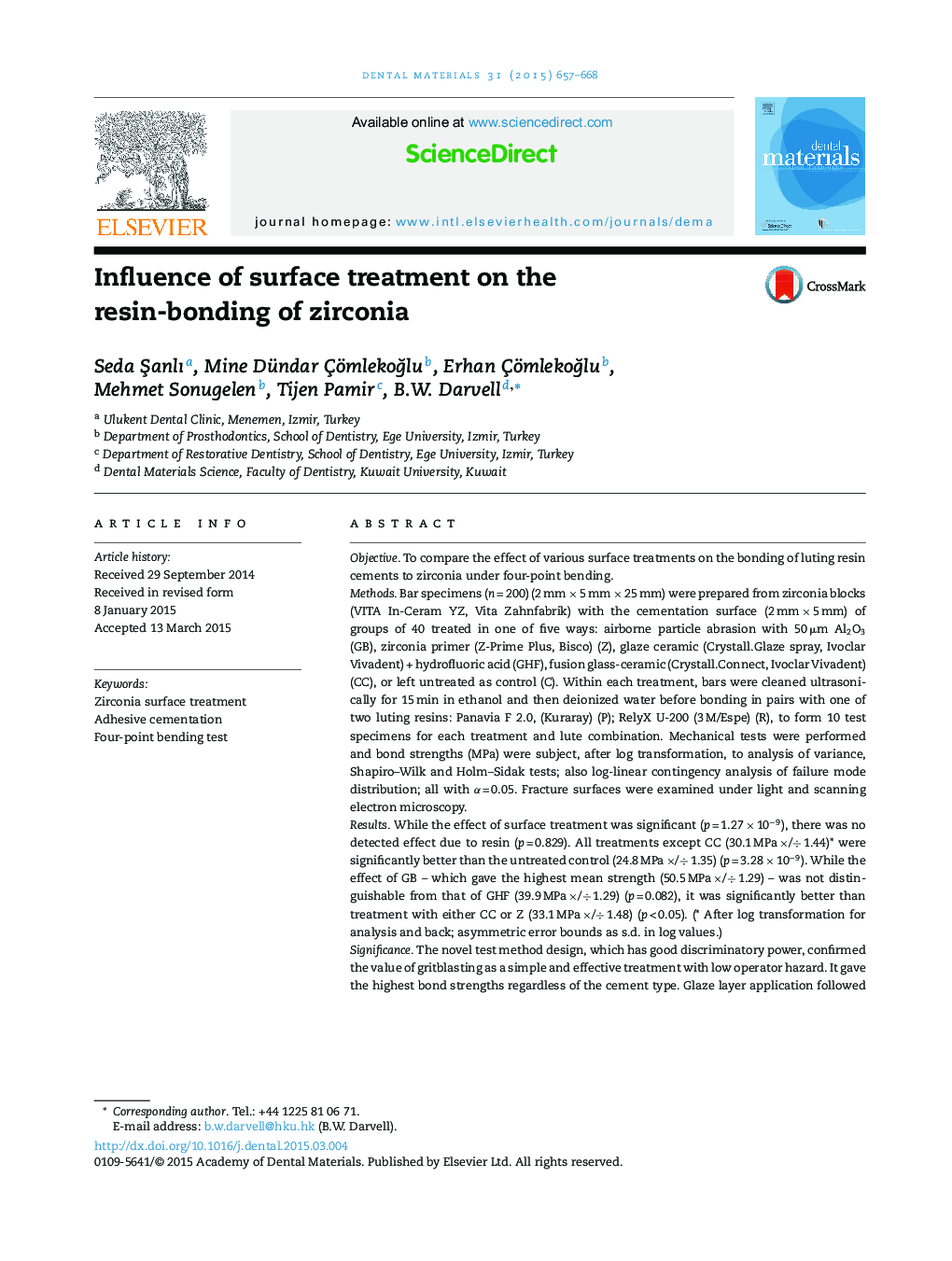| کد مقاله | کد نشریه | سال انتشار | مقاله انگلیسی | نسخه تمام متن |
|---|---|---|---|---|
| 1420659 | 986378 | 2015 | 12 صفحه PDF | دانلود رایگان |
• We introduce a symmetric four-point bending test for adhesion testing.
• Simple gritblasting alone may be the currently optimized procedure that can be done.
• EDS is needed to complement light and scanning electron microscopy for full fracture evaluation.
ObjectiveTo compare the effect of various surface treatments on the bonding of luting resin cements to zirconia under four-point bending.MethodsBar specimens (n = 200) (2 mm × 5 mm × 25 mm) were prepared from zirconia blocks (VITA In-Ceram YZ, Vita Zahnfabrik) with the cementation surface (2 mm × 5 mm) of groups of 40 treated in one of five ways: airborne particle abrasion with 50 μm Al2O3 (GB), zirconia primer (Z-Prime Plus, Bisco) (Z), glaze ceramic (Crystall.Glaze spray, Ivoclar Vivadent) + hydrofluoric acid (GHF), fusion glass-ceramic (Crystall.Connect, Ivoclar Vivadent) (CC), or left untreated as control (C). Within each treatment, bars were cleaned ultrasonically for 15 min in ethanol and then deionized water before bonding in pairs with one of two luting resins: Panavia F 2.0, (Kuraray) (P); RelyX U-200 (3 M/Espe) (R), to form 10 test specimens for each treatment and lute combination. Mechanical tests were performed and bond strengths (MPa) were subject, after log transformation, to analysis of variance, Shapiro–Wilk and Holm–Sidak tests; also log-linear contingency analysis of failure mode distribution; all with α = 0.05. Fracture surfaces were examined under light and scanning electron microscopy.ResultsWhile the effect of surface treatment was significant (p = 1.27 × 10−9), there was no detected effect due to resin (p = 0.829). All treatments except CC (30.1 MPa ×/÷ 1.44)* were significantly better than the untreated control (24.8 MPa ×/÷ 1.35) (p = 3.28 × 10−9). While the effect of GB – which gave the highest mean strength (50.5 MPa ×/÷ 1.29) – was not distinguishable from that of GHF (39.9 MPa ×/÷ 1.29) (p = 0.082), it was significantly better than treatment with either CC or Z (33.1 MPa ×/÷ 1.48) (p < 0.05). (* After log transformation for analysis and back; asymmetric error bounds as s.d. in log values.)SignificanceThe novel test method design, which has good discriminatory power, confirmed the value of gritblasting as a simple and effective treatment with low operator hazard. It gave the highest bond strengths regardless of the cement type. Glaze layer application followed by hydrofluoric acid-etching on zirconia before cementation might be viable for adhesive zirconia cementation, but represents a much greater hazard as well as having problems with thickness control.
Journal: Dental Materials - Volume 31, Issue 6, June 2015, Pages 657–668
